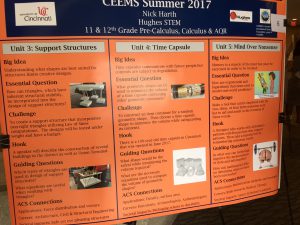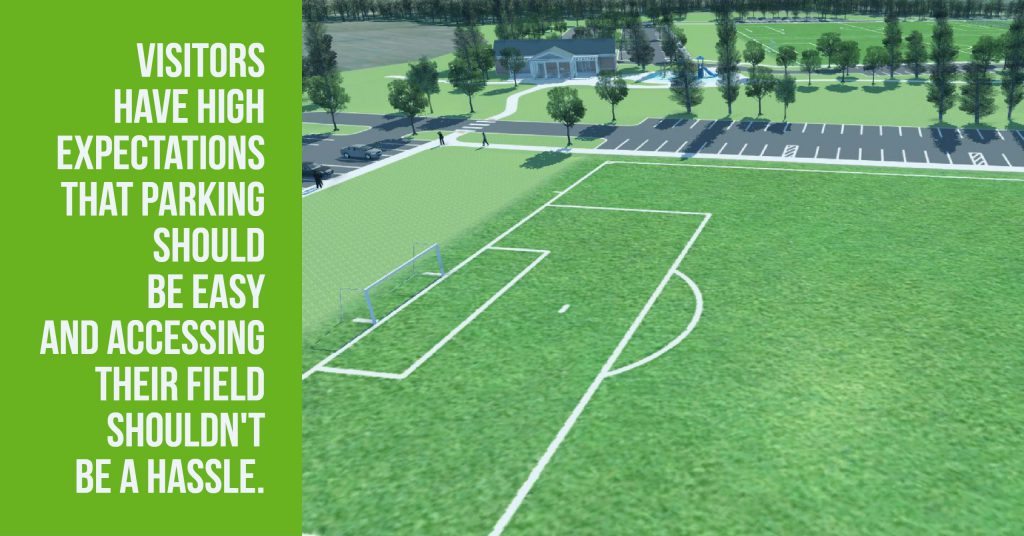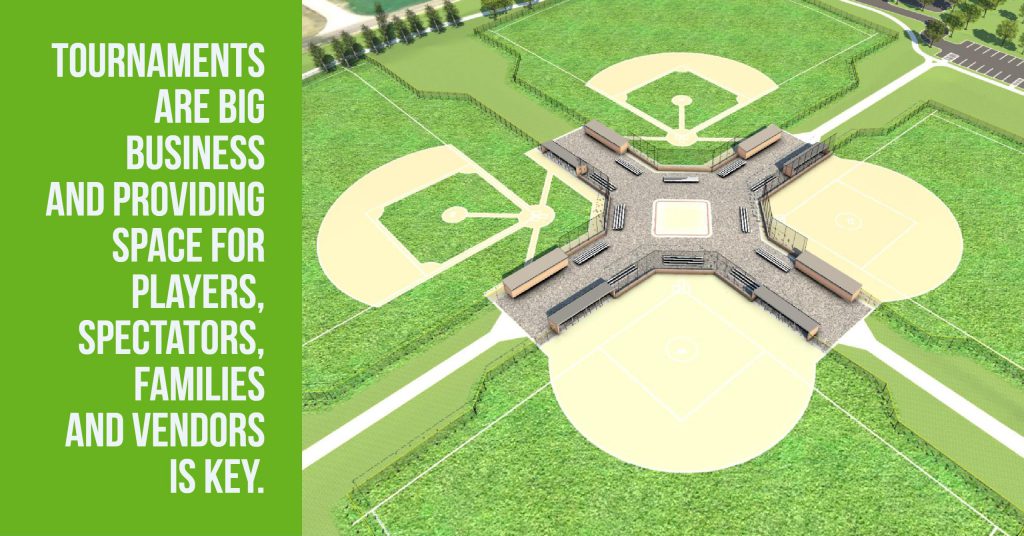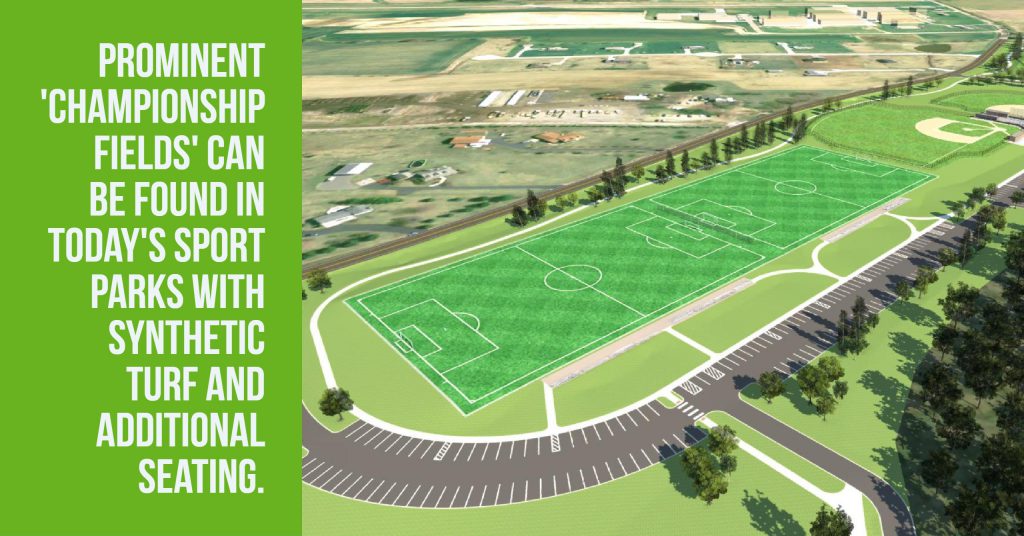Tennis Court Rust Spot Repair Options
Remediation offers various solutions, but the following are the ones most frequently discussed:
- Remove the contaminated aggregate.
- Cover the contaminated aggregate with an acrylic surface coating utilizing a rust inhibitor/stain blocker.
- Cover the contaminated aggregate with a polyurethane surface coating.
- Cover the contaminated aggregate with a tennis court “mat” system.
- Cover the contaminated aggregate with a new surface course of asphalt.
Option 1 – Remove the Aggregate:
Summary – Contractor drills out all the visible iron pyrite. The holes are patched with an acrylic patch binder. Apply rust inhibitor and new court surface paint.
- Pros – The source of the staining is completely removed from the surface.
- Cons – May not get every piece of iron pyrite.
- Cost – Medium, labor-intensive
- Level of Success – High
Option 2 – Cover aggregate with an acrylic surface coating for tennis courts utilizing a rust inhibitor/stain blocker:
Summary – Contractor applies rust inhibitor. Either paint on exposed aggregate, covers the entire court, or both; one or two coats. Some products are installed as a primer, while some are mixed with the color coatings. The initial coat is intended to “encapsulate” the iron pyrite. Products mixed in with the surface are intended to minimize staining. The rust inhibitor products are generally products developed to improve bonding to greasy or oily surfaces. These are what encapsulates the iron.
- Pros – Simple installation. Common in many industries.
- Cons – Iron pyrite that is not exposed is not “encapsulated.” Latex is a permeable breathable surface. The permeability allows moisture into the surface which can contact iron that is not encapsulated which will then rust and stain the new surface. Be aware that rust spots will come back through the surface. The rate of success is as low as 60% to as high as 85%. Rust can be expected to reappear in two to five years.
- Cost – Medium
- Level of Success – Medium
Option 3 – Cover the contaminated aggregate with a polyurethane surface coating:
Summary – A polyurethane waterproofing membrane is installed across the entire court.
- Pros – The polyurethane coating is non-permeable, which stops surface water from reaching the iron pyrite.
- Cons – Trapping moisture under the surface and not allowing it to breathe could cause blistering. Moisture from under the surface being heated on hot summer day, forcing water vapor to rise and hit the iron pyrite, causes rust which may push through the surface.
- Cost – Medium-high
- Level of Success – Medium to high
Option 4 – Cover the contaminated aggregate with a “mat” system:
Summary – A thick (+/- 3/16”) mat court system is installed across the entire court area.
- Pros – The surface is guaranteed for 25 years. The surface will prevent asphalt cracking, the most common failure mechanism for outdoor asphalt courts, from reaching the surface.
- Cons – Below surface water could push through the surface carrying rust particles and stain the surface.
- Cost – Very high
- Level of Success – High
Option 5 – Cover the contaminated aggregate with a new surface course of asphalt:
Summary – Install a new course of asphalt with properly sourced aggregate and re-paint courts.
- Pros – Extends life to the existing courts.
- Cons – Requires milling or raising of net posts will have a lip at the fence edges.
- Cost – Medium-high
- Level of Success – High
Sources of Information:
- Paul Harris, California Products – Internationally known tennis court surface manufacturer.
- Rob Righter, Nova Sports U.S.A. – Internationally known tennis court surface manufacturer.
- Andreas Schulze Ising, American Polymer Technologies (APT) – Internationally known polymer company specializing in sports surfaces.
- Jeff Gearheart, SportMaster Coatings – Nationally known tennis court surface manufacturer (also has pavement sealant side of business).
- Chuck Sperrick, Neyra Industries – National tennis court surface manufacturer (also has pavement sealant side of business).
- Jeff Henderson, Tennis Technology – Regional Tennis Contractor.
- Jim Lathrop, Total Tennis – Regional Tennis Contractor.
- Rich Vettle, ABCO Paving – Regional Tennis Contractor.
- David Baird, Industrial Surface Sealer, Inc. – Regional Pavement Maintenance Contractor.
Funding Specialist, Joe Cottrill, Joins The Kleingers Group
The Kleingers Group is pleased to announce the addition of Funding Specialist, Joe Cottrill. Clients can expect to benefit from Mr. Cottrill’s extensive knowledge of available funding, application processes, and guidelines. He will assist and advise Kleingers’ clients regarding potential funding for the community’s capital improvement projects.
Joe served 22 years as Project Funding Coordinator with the Hamilton County Engineer’s Office where he gained in-depth knowledge of local, state, and federal funding programs through his involvement with the State Capital Improvement Program, Local Transportation Improvement Program, Small Government Commission Funds, Municipal Road Fund, Clean Ohio Revitalization Fund, and the Job Ready Sites Program.
Here, Joe was responsible for administrating the laws of ORC to make the Ohio Public Works, work. Joe was also responsible for advertising programs for upcoming funding rounds, reviewing applications, establishing the rating scores, and making recommendations.
He also served as the Liaison Officer for the Ohio Public Works Commission District 2 Integrating Committee for 22 years. He was awarded a Certificate of Appreciation from the Ohio Legislature in 2010 for his work with the District 2 Integrating Committee. Joe also was with the Washington County Engineer’s Office in Marietta, OH for eleven years as a design technician and bridge inspector before moving to Cincinnati. Here Joe developed his bridge inspection experience.
His career in the industry began at the age of 15, where he began work for his father’s company, Calvin Construction Company until he left for college. The construction company, since dissolved, specialized in roadways, bridges, and dams. In Joe’s years with his dad’s company, he earned money to help put himself through college and gained tremendous knowledge about public construction. Joe received his B.A. degree in Theology from Bob Jones University in Greenville, SC in 1982.
When asked why Joe chose to join The Kleingers Group, he responded,
“I was motivated the most by my knowledge of Kleingers’ good reputation in the industry. Their plans are well thought out and helped make my life easier for my colleagues at the County, especially the reviewers. When engineers do not take the time to think through their designs, it makes life a lot tougher for reviewers. Kleingers is known for their high-quality work, which is always well thought out.”
He also went on to share that he has known Tim Casto for a long while and how the two of them became good friends over time.
Joe retired from public service in December 2010 and has worked in the private sector since. He is married to Kimberly Steele Cottrill, has two grown children, and an adorable dog named Sophie (who runs the house). In his spare time, Joe enjoys building scale models of cars and trucks. He claims he is not a ‘Master Modeler’ (which is apparently a real job in the scale model world), he plans to stick to just the hobby.
Linking Real-World Engineering Problems to K-12 Educators & UC CEEMS
Studies have shown for decades that the integration of STEAM programs within K-12 education is important to the development of students. These programs are designed to set up children earlier with a strong understanding of STEAM skills, while cultivating students as a future interest for national economic prosperity.
Over the past several years Steve Korte, Group Leader for Kleingers’ Southwest Ohio Institutional Group, has volunteered in many ways for the University of Cincinnati CEEMS program. The Cincinnati Engineering Enhanced Mathematics and Science Program (CEEMS) is led by the University of Cincinnati in partnership with 14 Cincinnati-area school districts. One of the main goals of UC’s CEEMS program is “real world applications: connections to engineering,” and the classroom presentations provide great linkage for the students in understanding how the subjects they are learning apply to the “real world.”
 During the program, teachers design a challenged-based learning activity to engage their students in decision making, strategic planning and evaluate plan revisions. At the end of each session, participating teachers are given the opportunity to present their final “units,” displays and videos for judging. Steve served as a volunteer judge during the Closing Day Showcase earlier this month, providing constructive feedback and guidance to the educators.
During the program, teachers design a challenged-based learning activity to engage their students in decision making, strategic planning and evaluate plan revisions. At the end of each session, participating teachers are given the opportunity to present their final “units,” displays and videos for judging. Steve served as a volunteer judge during the Closing Day Showcase earlier this month, providing constructive feedback and guidance to the educators.
“As a graduate of the UC College of Engineering, I take tremendous pride in being able to connect back via CEEMS,” says Steve. “It is a great way for me to give back to my community all while educating the stewards for the next generation of engineers” he continues.
The Oak Hills School District, Steve’s alma mater, is a partner in the CEEMS program. “Many of my formal education worlds come together through the CEEMS program. I have been able to take back my professional experience and college education at UC to teach students about how math and science really come together. I even had the opportunity to present at Delhi Middle School, my old stomping grounds,” Steve shared.
Through many years of volunteering, Steve has grown many relationships with teachers and administrators in the Cincinnati area, which has led to several classroom presentations to middle school and high school math/science students. Steve has also sat on numerous panels in an open forum with math and science teachers to discuss what engineering companies are looking for in college graduates (technical skill sets, software programs and soft skills).
“As a group of engineers, surveyors and landscape architects who use math, arts and sciences every day, it is important to myself and others at Kleingers to educate teachers. Giving teachers the tools to explain real-life applications and how STEAM subjects impact their students’ future careers is huge,” says Steve.
To learn more about the University of Cincinnati’s CEEMS program, visit their website: http://ceas.uc.edu/special_programs/ceems/CEEMS_Home.html
Learn more about the “Closing Day Showcase” here: http://ceas.uc.edu/news-1314/ceems-closing-day-showcase-facilitates-promising-classroom-resul.html
10 Things to Consider When Planning a Sports Park
It’s not every day that an Owner takes on planning a 100+ acre sports park, but when the scenario arises, The Kleingers Group brings proven experience to the team. Over the years, Kleingers has designed a number of large-scale sports parks and has found that many of the same considerations tend to come up during our design process. We would like to share with you what to consider before you take on your sports park design.
1. Connect to Existing Community Assets
Creating transportation linkages to other community resources such as parks, schools, YMCAs, and more will encourage participation at the new development. Pursue ways to blend the new park with its surroundings and work with neighbors and stakeholders to build support for the project. Leverage connections through existing infrastructure like trailways, complete streets, and other multi-modal systems will provide easy access for bicyclists and pedestrians who visit the facility.
2. Create a Site that is Safe, Easy to Use, and Navigate
Speaking of connecting the site with pedestrians, it’s also important to design ways to keep them safe, especially from vehicular traffic. Maintain separate vehicle travel zones and pedestrian travel zones when possible and provide for safe and clearly marked crosswalks to help minimize conflicts. Branding, wayfinding, and creative use of landscape theming will help visitors with vehicles travel to their destination within the site more efficiently while minimizing user frustration.
Oftentimes, large sports complexes lack adequate wayfinding due to oversight or budget concerns. Proper wayfinding design can help users get to where they need to be while also creating a recognizable brand for the sports park and the associated owner.
3. All Sports Park Owners are in the Parking Business
Did you know that many competitive organizations that bring tournaments to sports parks require minimum parking per event? Organizers hosting tournaments require anywhere between 50-100 spaces per field, some require even more. Believe it or not, sports park owners are in the parking business. Visitors have high expectations that parking should be easy and accessing their field shouldn’t be a hassle. Tournament organizers must meet the demands of their clients, which means balancing the site’s infrastructure is important to everyone’s bottom line. Planning for enough parking close to destination points within the design allows for better traffic flow and provides better ADA access throughout the site. The site layout needs to balance ease of access without being interrupted by large parking areas, or losing the vibrancy of an active and energized park.

4. Plan for Flexibility: Master Planning the Site for Optimum Use
Creating a park with the most flexible layouts will mean more options for end-users. Engineering the field grading is a key component. Fields should be carefully engineered to accommodate high-end games and large events with the ability to host smaller games within the same space without compromising the playable area, including crowns and field orientation.
Master planning a complex for multiple sports provides flexibility when attracting special events. Understanding how to plan for and design sports parks for flexibility amongst sports, whether soccer, football, lacrosse, rugby, Australian football, ultimate frisbee, baseball, softball, or cricket will attract a larger audience. Knowledge of national sports trends will allow the field designer to guide a client through the planning stages while meeting their needs and measured desires within the area.
5. Coordinate with Local Municipalities
Working with local interests and shareholders during the design process helps to ensure that everyone has a voice in the process of designing the sports park. Creating opportunities for partnerships early will help generate buy-in from key stakeholders and community members. Our experience in working through this relationship helps guide programming, affordability, and ultimately desired priorities.
6. Plan for Extra Traffic in the Area
More often than not, any new development brings additional traffic to a site. Traffic engineers can provide traffic studies to better understand current traffic conditions and anticipated changes and recommendations.

7. Sports Engineering is Key: Grading, Drainage & Field Performance Will Keep Them Coming Back
Creating space for tournaments is big business and retaining that business helps any sports park be successful. If the grading, slopes, drainage, playing surfaces, and other amenities are not designed properly, tournament organizations will take their business down the road to the competing sports park. Competitive organizations have a business to run and their business model depends on feedback from players and parents who use the fields, facilities, and park amenities at these events. Positive survey feedback will increase the chances that they return again for another event.
8. Plan for Attendees Who are not Players or Spectators
A large portion of the sports park business is creating a fun and comfortable experience for attendees. Creating spaces, such as playgrounds, within eyesight of a group of playing fields keeps that family with one child playing in the game and another bored on the sideline entertained and comfortable. Providing a trail system allows for visitors to take a break between tournament games, connect to another game across the complex, or meander to a ‘hub’ with concessions and restrooms nearby. Trails also appeal to pedestrians and bicyclists across the community.
9. Create a Space for Vendors
An often-overlooked element of the sports complex business is providing adequate space for vendors who are often on hand during a sporting event selling sports equipment, promotional items, and more to parents and other attendees. Creating ‘vendor zone’ spaces convenient to tournament sites is a key selling point to those looking to bring competition to the area.
10. Plan for Championships and Celebrations
Another trend in design that we see is the inclusion of championship fields. These higher-quality fields, sometimes utilizing synthetic turf, are designed with more seating and are typically located in prominent areas of the complex to draw more crowds as competitions wind down. Additionally, we see the integration of amphitheater spaces where teams celebrate their accomplishments with awards ceremonies.
Summary
These design considerations are a fraction of the items to explore when creating a sports park. At Kleingers/Sportworks, we understand the business of sports parks, the competition that takes place inside and outside the park, and the investment owners take in creating these opportunities for revenue. We also understand good engineering, traffic, sports field engineering, survey and landscape design, and the importance of getting all of these things done right for the bottom line and ultimate success of any sports park complex.